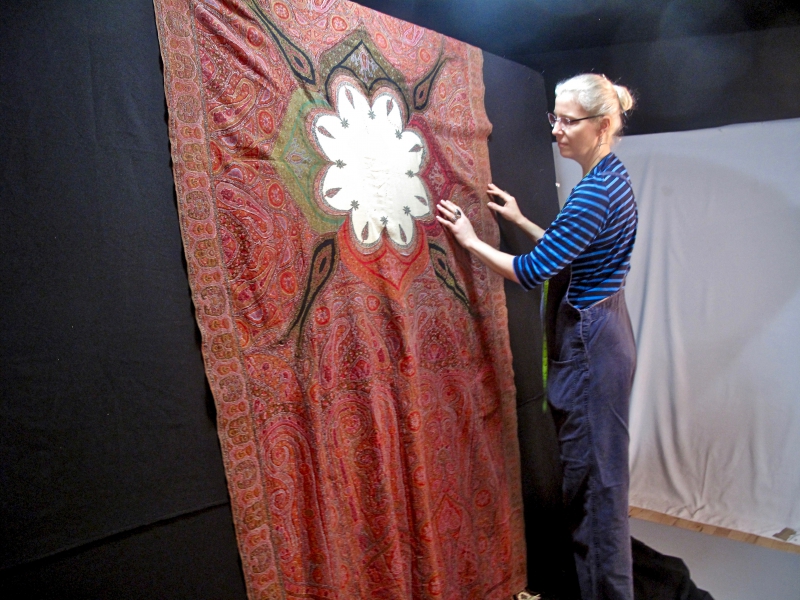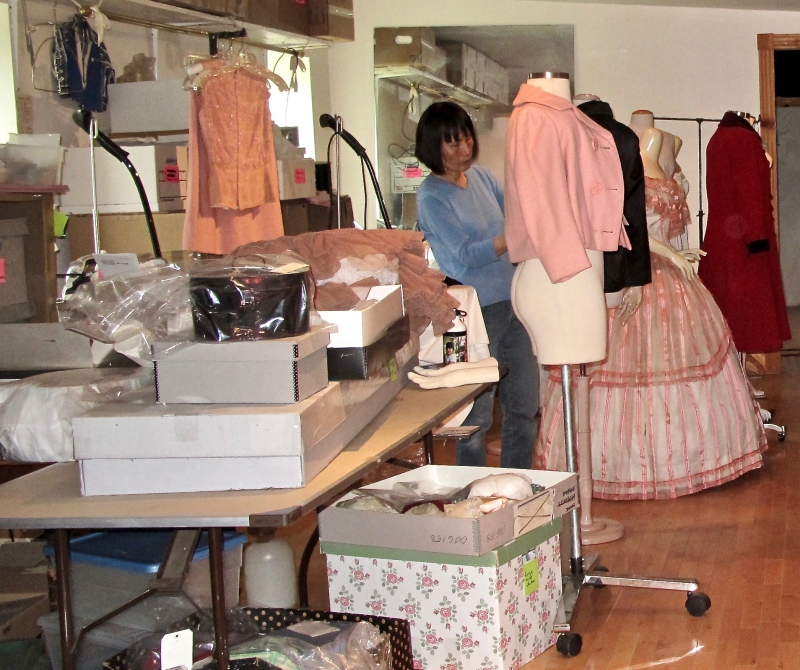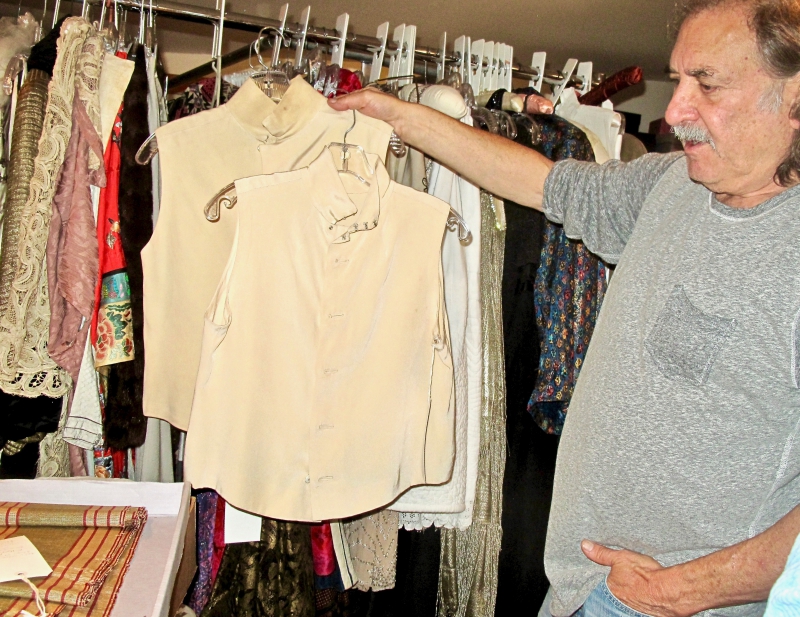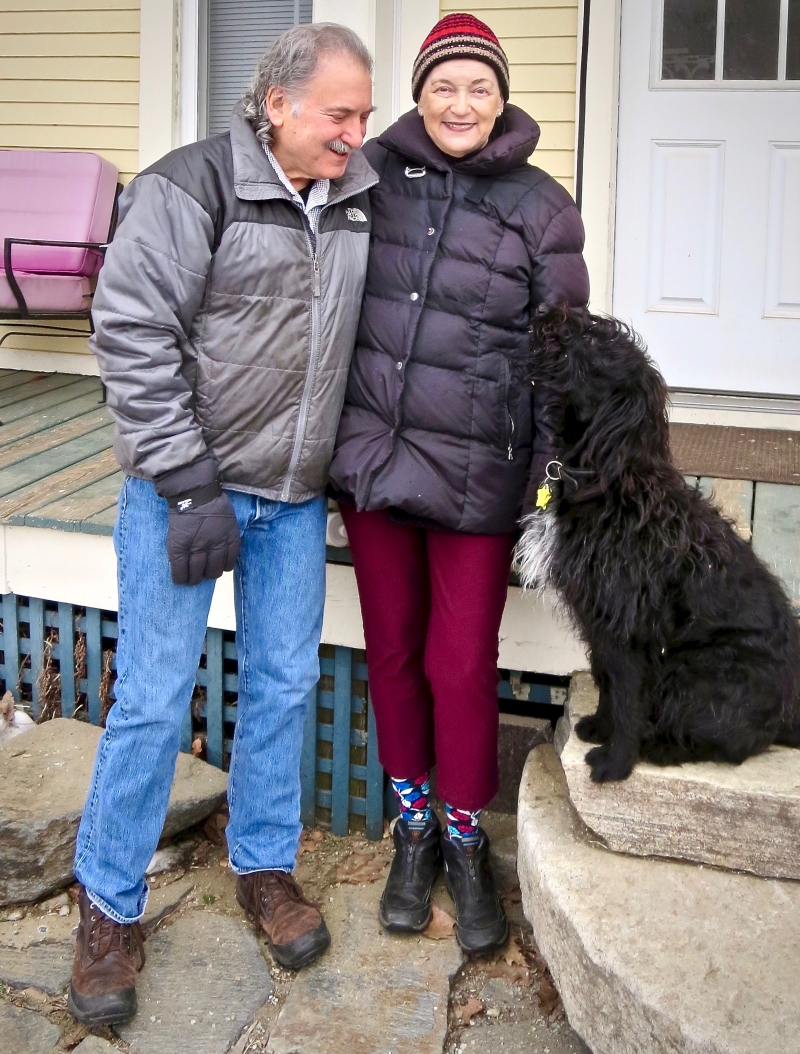By Arlene Distler
An old farmstead in Bellows Falls may seem an unlikely location for an international auction business, but Augusta Auctions thrives there, situated on bucolic property behind busy Route 5. Augusta Auctions, an intensely curated sell-point for fine vintage clothing and accessories, had inauspicious beginnings but has grown into a world-class enterprise, sending prized and nearly priceless vintage clothing around the globe.
Karen Augusta had been collecting vintage clothing since her college days in the ‘60s. Her first retail outlet, started in 1978, was a shop in New Jersey. Eventually she had a shop in Chester, Vt. as well.
In 1985, Augusta reconnected with Bob Ross, an acquaintance from college days, at their college reunion. A year later the two moved into a long-abandoned property Ross had bought in the ’70s and had renovated off the main drag in Bellows Falls. The property had good business pedigree. It had belonged to Frank Wilson, who started Basketville. He raised his family in the farmhouse. A large outbuilding, in great disrepair by the ‘70s, was where baskets had been made and stored.

Julia Borden, researcher and Augusta’s right-hand woman, prepares a hand-woven wool kashmiri shawl, mid-19th century, for the photo on the auction’s website.
Throughout the ‘80s and ‘90s, Augusta brought her collection to weekend antique shows and had a shop in Chester.
In 1999 Augusta was asked to sell a large stock of vintage clothing that had belonged to a dealer who’d died. Unable to find a suitable outlet, Ross told Augusta she’d have to sell it herself. Thus began Augusta’s introduction to the world of auctions, despite her being “petrified” at first, she recalls. During this period interest in vintage fashion exploded, spurred by high-profile museum shows.
Augusta hired an auctioneer and the couple worked together for eight years, doing auctions in New Hope, Penn. At that point Ross, who’d been a real estate agent for 20 years, decided he’d had enough of that business and became a full-fledged partner in the vintage clothing business with his wife.
The decision was fortuitous. The next year, the Metropolitan Museum of Art in New York gave Augusta 15,000 pieces of vintage clothing, the entire collection of the Brooklyn Museum, which was disposing of that department. “It took about five years to sell everything!” says Augusta. “We would go to New York every four months or so with a big truck, and take pieces back with us.” They did not sell them all at once because, says Ross, “We attempt to balance each sale with most eras and styles represented.”

Seamstress Kazuko Jonas is “August Auctions’ “mannequin whisperer; just by feeling the bodice of a dress she can tell what size it is.”
When Augusta and Ross moved to the property, the top floor of the farmhouse served as the storage and sorting area. Deciding they needed more space (and tired of going up and down stairs), in 2006 the couple renovated the outbuilding. Says Augusta, “We could never have afforded that amount of space elsewhere, say in Connecticut or Massachusetts. It was perfect: It even had a loading dock!”
Augusta, an acknowledged expert in her field, is called upon as a consultant by museums, appraisers, and non-profits. For 13 years she was the clothing consultant on “Antiques Roadshow.” Because of her many years researching pieces of vintage fashion, the Augusta Auction website is also used as a resource by schools and dealers.
Confesses Augusta, “It has always been what I love most: researching the history of an article that comes to us.”
Like the zoot suit brought to them from an attic in New Jersey that Augusta learned was, at the time it was made, (1938–42) illegal, because there was a rationing of fabric during the war, and zoot suits were thought to use an excessive amount. Riots took place (Wikipedia has an entry for Zoot Suit Riots). Latinos and African-Americans favored the outfits. Servicemen felt wearing them was unpatriotic, and accosted them. Few were made and many zoot suits were burned. The garment auctioned by Augusta Auctions was the only zoot suit known to exist in its original condition, and it went for $78,000 to the Los Angeles County Museum of Art, an auction record for men’s fashion.
 In the warehouse, preparing clothing for auctions and cataloging it, is a team “to rival any in the field,” says Ross.
In the warehouse, preparing clothing for auctions and cataloging it, is a team “to rival any in the field,” says Ross.
Julia Borden came on as an intern six years ago while studying fashion history at the Fashion Institute of Technology in Manhattan. She researches pieces and is Augusta’s right-hand woman, checking to make sure information that goes with an article of clothing is correct. Says Borden, “I love to take something rumpled in a box and make it look fabulous!” She does the hands-on essential work of steaming, ironing, and then protecting the clothing by laying garments out in acid-free boxes.
Borden is assisted by Julia Ricklis, whose background is jewelry. “What I love about this job is you get to see things you wouldn’t see except in a museum. Here I get to touch them,” Ricklis says.
Seamstress Kazuko Jonas has worked at the Augusta home for 21 years. She is, says Borden, “our manikin whisperer; just by feeling the bodice of a dress she can tell what size it is.” This is an important talent, as many vintage dresses pre-20th century do not contain labels—neither size nor brand. Kazuko has the gentlest of touches. Only slight alterations are made, such as a strap that may need reattaching, a seam in need of a few stitches. For the most part clothing is sold as is, with full disclosure in the description. Usually a museum, or other collector of fine vintage clothing, would rather a piece be authentic than perfect.
Augusta Auctions puts up for bid the creations of such world-famous designers as Dior, Saint Laurent, Balenciaga, Bill Blass, and Pierre Cardin. Much of the inventory comes from museums and estates, but occasionally a great find may come from someone’s attic. Such was the case at a recent Manhattan auction, where the most intense bidding of the afternoon was over a circa-1860 bubblegum pink ball gown that came from the attic of a prominent New York City family. It had, as well, a label identifying its designer—Mon. Vignon, Paris—a rare occurrence in a piece that old. It went for tens of thousands of dollars to a museum in Spain.
Donna Karan and Stella McCartney are among the designers that have taken their inspiration from clothing they purchased at Augusta Auctions. Sometimes, says Augusta, designer will take a motif from a piece of fabric, or copy a feature of a dress or jacket, and incorporate it into an original design.
When the internet became the tool for selling, Ross created a website for Augusta Auctions. Calling himself an early adopter of computer technology (he had created the first website for real estate in SoVT) Ross brought the couple’s auction business into the 21st century. In fact, says Augusta, “the internet has allowed our business to flourish in Vermont—you can reach the whole world!”
Because bidding for high-end articles is based largely on photographs, a professional photographer keeps a studio space in the receiving building, where Borden, Kazuko and Ricklis dress the manikins, place the hat just so, etc. The photographs, which aim to make an article look as attractive as possible, are also used to show a piece’s imperfections. Interested parties can view the fashions as images are uploaded to the site, starting months ahead of the auctions, and can leave a bid. Auction news is also posted to the Augusta Auctions Facebook page and on Instagram.
More in line with what mere mortals can hope to bring home is the May auction, this year held May 14–15 in Sturbridge Village, Mass. It’s timed to coincide with the sprawling Brimfield Antique Show, the largest of its kind in the country. Here, the draw is the Discovery auction, held on the second day. Large box lots of vintage clothing are deposited on a long table and buyers can pick out their discoveries, which are then held out and bid on, starting at $25. Attendees crowd around while the knowledgeable Borden calls out a piece’s historical context. What remains is then sold as a box lot for $25.
The Discovery auction is not on the internet, so one must attend. Because presumably you would do best if you know what you are looking for, the Discovery auction is popular with dealers. But it is also like an auction version of Filene’s Basement, Augusta says, with comparable excitement at getting a bargain. Ross calls Discovery “the ultimate treasure hunt” and attests that people come from Italy, France, England, Japan, and so many more places abroad. “I may ship to 20 countries when we’re through,” Augusta explains.
Augusta and Ross say they owe their success to their research. Here again, the internet is hugely important.
“Telling people just what they have is an important part of our business,” Augusta says. As when she found a trove of medals at the bottom of a box received from a Vermont woman. Ross, via internet searches, discovered they belonged to the second in command to Chiang Kai-shek, a “Tiger General” who’d escaped to the West during China’s Cultural Revolution. A press release about the find was translated into Chinese and found its way to social media in Taiwan. Thus alerted, a relative of the general flew from Taipei to New York and bought the medals to take back to China.
Thanks to Augusta’s love of fashion and history—and Ross’s business acumen, the internet, and a coterie of other talented people—Bellows Falls in SoVT has played its part in making the world a smaller place!






















































